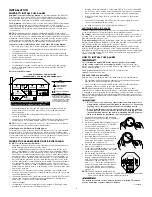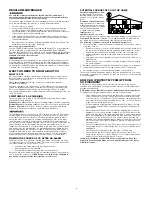
3
9. Align the tabs on the base with the tabs on the mounting bracket.
Turn the base until it snaps into place.
10. If the cover does not line up the way you wanted, adjust it by slowly
rotating it in either direction.
11. Test the Smoke/CO Alarm. See “Weekly Testing” for details.
IF YOUR SMOKE/CO ALARM SOUNDS
WHAT TO DO FIRST–IDENTIFY THE TYPE OF ALARM
Type of Alarm
What You See and Hear
Carbon Monoxide (CO)
CO Light:
Flashing RED
Horn:
4 beeps,
pause, 4 beeps, pause
Smoke
Smoke Light:
Flashing RED
Horn:
3 beeps,
pause, 3 beeps, pause
Problem...
What You See
Indicates:
and Hear
You Should...
Low Battery
Battery Light:
Battery is Low:
Flashing GREEN
Install new 9V alkaline or
Horn:
Chirps
lithium battery. For a list of
every 30 seconds
acceptable replacement
batteries, see “Regular
Maintenance.”
Service
Service Light:
Device is not Working
Flashing YELLOW
Properly:
See “Testing
Horn:
3 quick chirps
and Maintenance”.
every 30 seconds
IF THE CO ALARM SOUNDS
Actuation of your CO Alarm indicates the presence of carbon monoxide
(CO) which can kill you. In other words, when your CO Alarm sounds, you
must not ignore it!
IF THE CO ALARM SOUNDS:
1. Operate the Test/Silence button.
2. Call your emergency services, fire department or 911. Write down the
number of your local emergency service here:
__________________________________________________________________
3. Immediately move to fresh air—outdoors or by an open door or window.
Do a head count to check that all persons are accounted for. Do not re-
enter the premises, or move away from the open door or window until the
emergency services responder has arrived, the premises have been aired
out, and your CO Alarm remains in its normal condition.
4. After following steps 1-3, if your CO Alarm reactivates within a 24-hour
period, repeat steps 1-3 and call a qualified appliance technician to inves-
tigate for sources of CO from fuel-burning equipment and appliances, and
inspect for proper operation of this equipment. If problems are identified
during this inspection have the equipment serviced immediately. Note any
combustion equipment not inspected by the technician, and consult the
manufacturers’ instructions, or contact the manufacturers directly, for more
information about CO safety and this equipment. Make sure that motor
vehicles are not, and have not, been operating in an attached garage or
adjacent to the residence. Write down the number of a qualified appliance
technician here:
__________________________________________________________________
“ALARM-MOVE TO FRESH AIR”
If you hear the alarm horn sound 4 beeps,
pause, 4 beeps, pause, and the RED CO
light is flashing, move everyone to a
source of fresh air.
IF THE SMOKE ALARM SOUNDS
RESPONDING TO AN ALARM
•
If the unit alarms and you are not testing the unit, it is warning you
of a potentially dangerous situation that requires your immediate
attention. NEVER ignore any alarm. Ignoring the alarm may result in
injury or death.
•
Never remove the batteries from a battery operated Smoke Alarm to
stop an unwanted alarm (caused by cooking smoke, etc.). Removing
batteries disables the alarm so it cannot sense smoke, and removes
your protection. Instead open a window or fan the smoke away from
the unit. The alarm will reset automatically.
•
If the unit alarms get everyone out of the house immediately.
WHAT TO DO IN CASE OF FIRE
• Don’t panic; stay calm. Follow your family escape plan.
• Get out of the house as quickly as possible. Don’t stop to get
dressed or collect anything.
• Feel doors with the back of your hand before opening them.
If a door is cool, open it slowly. Don’t open a hot door. Keep doors
and windows closed, unless you must escape through them.
• Cover your nose and mouth with a cloth (preferably damp).
Take short, shallow breaths.
• Meet at your planned meeting place outside your home,
and do a head count to make sure everybody got out safely.
• Call the Fire Department as soon as possible from outside.
Give your address, then your name.
• Never go back inside a burning building for any reason.
• Contact your Fire Department for ideas on making your home safer.
USING THE SILENCE FEATURE
Never remove the batteries to quiet an unwanted alarm. Removing the
batteries disables the alarm and removes your protection.
The Silence Feature is intended to temporarily silence the horn while you
identify and correct the problem. Do not use the Silence Feature in emergency
situations. It will not correct a CO problem or extinguish a fire.
To use the Silence Feature, press and hold the Test/Silence button on the
cover of the Smoke/CO Alarm for 3 seconds.
If you hear the alarm horn sound 3 beeps, pause,
3 beeps, pause and the RED SMOKE light is flash-
ing, smoke has been detected. Evacuate everyone
from the building.
When the Smoke Alarm is Silenced
When the CO Alarm is silenced
The Smoke Alarm will remain silent
for 8 minutes, then return to normal
operation.
If the smoke has not cleared–or con-
tinues to increase–the device will go
back into alarm.
The CO alarm will remain silent for
4 minutes.
After 4 minutes, if CO levels remain
potentially dangerous the horn will
start sounding again.
WEEKLY TESTING
• NEVER use an open flame of any kind to test this unit. You might
accidentally damage or set fire to the unit or to your home. The
built-in test switch accurately tests the unit’s operation as required
by Underwriters Laboratories, Inc. (UL). If you choose to use an
aerosol smoke product to test the Smoke Alarm, be certain to use
one that has been Listed to Underwriters Laboratories, Inc. Safety
Standards, and use it only as directed. Use of non-UL Listed prod-
ucts or improper use of UL Listed products may affect the Smoke
Alarm’s sensitivity, and may void your warranty. NEVER use vehicle
exhaust! Exhaust may cause permanent damage and voids your
warranty.
• DO NOT stand close to the Alarm when the horn is sounding.
Exposure at close range may be harmful to your hearing. When
testing, step away when horn starts sounding.
It is important to test this unit every week to make sure it is working prop-
erly. Using the test button is the recommended way to test this Smoke/CO
Alarm.
Push and hold the Test/Silence button on the cover until you hear a
“chirp.” The “chirp” marks the start of the self-test sequence.
• First, the BATTERY (green) and SERVICE (yellow) lights will flash
briefly—this is normal.
• Next, the Smoke Alarm will sound. The smoke symbol will flash, and
you will hear this horn pattern: 3 beeps, pause, 3 beeps, pause.
• Finally, the CO Alarm will sound. The CO symbol will flash, and you will
hear this horn pattern: 4 beeps, pause, 4 beeps, pause.
If the unit does not alarm, make sure the battery is correctly installed, and test
again. If the unit still does not alarm, replace it immediately.
NOTE:
During testing, if the yellow service light comes on and the horn
“chirps” 3 times, the device should be serviced or replaced. After test-
ing, if the horn starts to “chirp” every 30 seconds, replace the battery
immediately.
HOW TO INSTALL THIS ALARM, Continued





















